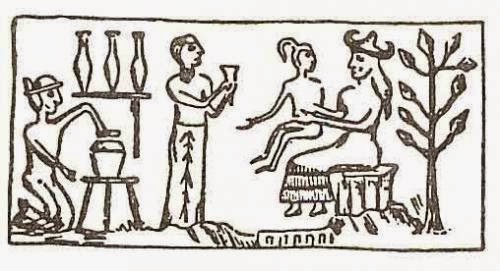WHY THE SERPENT IS THE EMBLEM OF THE HOUSE OF ENKI
A long, long time ago (in a galaxy not so far away - in fact, in the Milky Way itself), there was a "rebellion" amongst the Archangelic Host, as a result of which certain Aspects of the All-Being One "separated" from Source and began an experimental evolutionary spiral which eventually led them into the Metatronic Waveform Universe (where geometric structures, i.e. forms, take on a significance of their own).
Over countless aeons, these "Sons of God" (or, rather, SUNS of God) came to be known collectively as the Hosts of Lucifer - the Most Brilliant Lieutenant of the Most High.
Anyway, to fast-forward a little.... out of these so-called Luciferic Intelligences many technically proficient races evolved, and they began to colonize and inhabit suitable planets in various star systems. As they gained mastery over the elements and ways to apply their arcane knowledge, there was a corresponding loss of ability to FEEL. Cold logic gradually replaced the warmth of love pure and simple in these worlds.
Some of these technology-using races, like the Nibiruans (who had modified an entire planet into a bionic starship) eventually found themselves with serious environmental and atmospheric problems. Of course, they came up with a scientific solution: they needed gold particles to build a radiation shield around Nibiru. Lots and lots of gold particles - which their geological surveys found in abundance on the 7th planet (counting towards the Sun from Pluto) - which they called Ki (Firm Lands). Later Ki became Ge, and then Gaia-Terra, and so on.
And so about 440,000 years ago, Anu the God-King of Nibiru despatched his quarrelsome sons Ea and Enlil to Ki - their mission was to establish a base on this mineral-rich planet and dig for precious metals. Enlil (Lord of the Winds) was in charge of the orbiting station, while Ea (Lord of the Waters) landed on Ki to begin exploring and exploiting her mineral resources. Once the first Nibiruan Earth base - Eridu - had been established, Ea became known as Enki (Lord of the Firm Lands) while Ki became identified with Eridu (Erde/Eretz/Aratha/Earth) - the Sumerian word for "cultivated land."
More Nibiruans arrived on Ki - and they became known in Sumerian as the Anunnaki (Those Who From Heaven To Ki Descended), and in Hebrew as the Nefilim (Those Who Descended From The Sky).
For 144,000 Earth Years they toiled (1 Nibiruan Year = 3,600 Earth Years, so it was actually only 40 years to the Anunnaki) - until the atmosphere and magnetic field of the planet made them feel disgruntled and dissatisfied with their lot (this is the origin of the Greek myth of the Lotos-Eaters, retold in Tennyson's poem). The Anunnaki miners went on strike - and Enlil and Enki got into a huge argument about what to do.
Enlil was all for punishing the "mutineers" while Enki sympathized with his workers. He knew what a tough job theirs was. Finally, their half-sister Ninhursag had to intervene. She was a brilliant geneticist and healer, and she remembered that on some other colonies, android workers had been successfully created to perform menial tasks. At this, Enki's eyes lit up. He had spent a great deal of time studying the flora and fauna on Ki - and he had been observing a simian species that was well on its way to becoming hominid. Perhaps they could be genetically modified.....?
After repeated attempts, Enki and Ninhursag finally created the first Adama - an ape-angel hybrid. Fallen angels though they be, the space-orbiting Nibiruans - known as the Igigi or Watchers - who occasionally landed on Earth were described as Angels or God's Emissaries in the scriptures.
At first the Adama was sterile and was cloned in batches, a tedious process indeed. Eventually, Enki and Ninhursag came up with a self-reproducing model - and, voila! they had created our ancestors, Adam and Eve!
To the first humans, of course, the Anunnaki were literally Gods, Makers. In Hebrew the word God is usually the plural form Elohim (from which the Arabic form of Allah derives) - only much later did the "gods" divide up the colonized Earth into tribal zones - each tribe being subservient to a single, "jealous" God - like Abraham's Yahweh or Jehovah (known to the Greeks as Zeus and to the Romans as Jove or Jupiter).
Again, we must fast-forward to a period when the rival gods Enki and Enlil each had their own children, who unfortunately inherited their fathers' intense sibling rivalry. Enki was of somewhat different lineage from his half-brother Enlil (a full-blooded Nibiruan with "angelic" golden locks). Anu had taken a subsidiary wife named Id (or Ida) on Earth from amongst an ancient star tribe known as the Snake People. They were a subterranean species, dwelling in complex underground cities in the 4th Dimension and working with electromagnetic fields and crystals.
From this union Enki was born, and although he arrived before his half-brother Enlil, the latter took precedence in the Nibiruan succession because Enlil's mother Antu was Anu's half-sister (this genetic tradition was subsequently practised amongst the royal families of Akkadia, Babylon, Mitanni, Egypt and Assyria, and even amongst the Inca and Azteca). Anyway, these Sky Gods had countless offspring with their own kind as well as with the Lulus (a pet name for the domestic worker race evolved from the prototype Adama slave-android).
Enki, Lord of the Firm Lands, took on his mother's family emblem, the Serpent. Enlil, Lord of the Winds, had as his emblem, the Eagle.
Enki had four sons who were candidates for his dynastic succession: Ningishzidda (whose mother was of the Snake Race), Marduk, Nergal, and Dumuzi (or Tammuz). It was Marduk whose overweening ambition and arrogance made him vie for the Rulership of Egypt against his elder brother Ningishzidda. (In Egypt Marduk called himself RA and Ningishzidda was THOTH, god of scribes and esoteric wisdom). Not satisfied with being the Overlord of Egypt, Ra/Marduk plotted against the sons of Enlil and before long there were horrendous wars amongst the divine rulers of the entire planet - culminating in a nuclear attack on the Anunnaki spaceport in the Sinai Peninsula which caused untold havoc and misery for centuries - and which accounts for the arid conditions throughout the Middle East.
Once, and once only, Marduk was nearly destroyed when Enlil's granddaughter Inanna trapped him in the Ekur (the Great Pyramid) and ordered that he be buried alive. But after a while the Elder gods relented and released Marduk. From that moment Marduk became a fanatical Goddess-hater (his rise to power marked the beginning of a New Patriarchal Era wherein women were mercilessly oppressed, raped, and burnt as "witches").
Ra became known as Amen-Ra (Ra the Unseen) and relocated to Babylon where, as Marduk, he claimed supremacy over all the other gods, declaring war even against his own grandfather Anu. Such was Marduk's ruthlessness and singleminded will to rule that he eventually prevailed, causing Anu and Antu to flee Nibiru, which Marduk then captured and turned into a "Death Star" which enabled him to take virtual control of the Pleiades (of which our Solar System is part).
Today, Marduk has insinuated his influence into every facet of corporate existence - for he feeds on the negative emotional discharge of humans. FEAR, GUILT, ANXIETY, HATE, VIOLENCE, PAIN, WORRY, MISERY are Marduk's staple diet. As the masses of humanity succumb to a feeling of helplessness or powerlessness, Marduk's legions are thereby strengthened. The strength of the tyrant comes from the life force of his followers, which he sucks vampire-like from them via seemingly "legal" means.
In the old days, Marduk manipulated through brute force and raw terror. These days, he uses Advertising, PR, and his absolute control of Mass Media to achieve his ends... except in some countries (we don't have to name), where Marduk's principle of MIGHT IS RIGHT still manifests on the crude level of brute force.
Please bear in mind that 'Marduk' is an Archetype - a general principle that can operate through any number of willing or unwilling, conscious or unconscious human agents. Marduk's domains are ideological. He rules all the world's financial, military, academic and religious institutions (which includes, of course, the chief religion of our time, Mammonism - the worship of Money).
Through his vassal princes - the media moguls - Marduk has almost absolute control of the planet's mass communications systems - and therefore humanity's collective unconscious, the Matrix of Apparent Reality in which we enact our petty melodramas.
However, the Internet - thank Goodness - is still more or less uncontrollable (despite Echelon - an electronic surveillance system programmed to police the Information Superhighway). And remember: so long as we accept full responsibility for the way we experience and interpret the sensory data we call Reality, no one can hijack our higher evolutionary destiny. Not for long, in any case!
"[Here's a badly written but informative essay on our extraterrestrial origins.]"
Some rights reserved (c) Antares/Magick River
You may borrow and/or modify content for your own blog
but please credit and backlink, thanks.
























